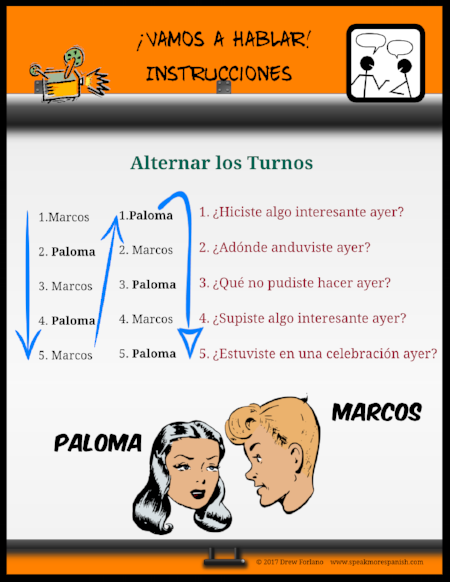Speaking in Spanish, or any other second language, can be quite daunting for students. How can we provide ample opportunity for students to practice speaking Spanish in a fun, relaxed manner? For me, the answer is simple - give them something good to talk about!
I have a few go-to activities for speaking that I love to use in class but one thing they all have in common is an interesting or funny question. For example, Why ask "What is your favorite food?" when you could ask "What is your favorite food to eat on your birthday?" or "What is one thing you never want to eat?" I can guarantee your students will think less about making mistakes and more about what they want to say, plus you will get some fun answers for follow up questions.
It's best if students pair up for speaking. Students will spend more time speaking to each other then in simple back and forth questions with the teacher. Think about it. Do you want one student answering your question or do you want ALL of your students answering questions at the same time? If you are looking for maximum time speaking Spanish, it's obvious that pair or small group speaking activities are the way to go.
There are a few rules to follow before attempting speaking activities like these:
Provide lots of comprehensible input for your students before asking them to speak. Students can't be expected to produce the language until they have been exposed to it numerous times. This means you have to practice vocabulary and questions using movie talks, games, and stories before you ask them to speak.
Model each activity your are using before doing it. Ask for two volunteers and ask these students to role-play the activity. Or do a quick ask and answer with a student to model what you need.
If students need more structure, let them write their answers first and then interview partners. This gives them time to think about the words they need.
Most importantly, write good questions! Keep it funny and interesting and you will get good results!
One last thing. I get very annoyed when students respond with a simple "And you?" after answering a question (instead of asking the full question). Here is a nice way to avoid this. It's called Alternating Questions. The example below from our Task Card Sets in our TpT store for the Spanish Irregular Preterite Verbs shows the format for doing this activity. You can easily write your own questions on the board and follow this format.
You can see in this example that Marcos asks question number one but Paloma does NOT ask question number one to Marcos. Instead, Paloma asks question number two, then Marcos asks question number three, and so on until they get to the bottom. Once there, they go back to the top and repeat the process. As long as you have an ODD number of questions, this format will work every time! Voila! No more responding with "And you?"
Check back another time for more fun speaking activities. Don't forget to sign up for our newsletter below for more tips and keep writing those great questions! #teachmorespanish #speakmorespanish
Comment below on some of your favorite speaking activities!

